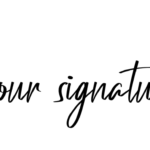What is a Handwritten Signature?
A handwritten signature is a unique mark made by an individual that is intended to be used as a form of identification. It is typically used to indicate the signer’s intent to accept the contents of a document or contract. Signatures can be made in a variety of ways, including with a pen, pencil, or stylus, and can vary in style, shape, and size. Signatures can also include additional elements such as initials, dates, and personal symbols.
A handwritten signature is an essential part of our identity and is required for a variety of legal documents, contracts, and agreements. A signature is unique to each individual and is a representation of their personality and style. Therefore, creating a perfect handwritten signature can be a challenging task for some people. In this article, we will provide you with some useful tips on how to create a perfect handwritten signature.
Understand the Basics
Before you start creating your signature, it is important to understand the basic components of a signature. A signature typically consists of three main elements: the first letter of your first name, the first letter of your last name, and a connecting stroke. The connecting stroke is what links the two letters together and creates a unique visual representation of your name.
These are basic components of a handwritten signature:
Line Quality
The first component of a signature is line quality. It refers to the way a person writes their signature, including the pressure, speed, and direction of the lines. The lines in a signature can be thick or thin, light or dark, or have varying thickness. They can also be smooth or jagged. The line quality of a signature reflects the writer’s confidence and individuality.
Size and Proportion
The size and proportion of a signature are also important components. The size of the signature can vary depending on the writer’s preference. However, it should be proportional to the document’s size and not too big or too small. The proportion of the signature is the relationship between the height and width of the signature. A well-proportioned signature gives an aesthetic appeal to the document.
Shape and Style
The shape and style of a signature are unique to each individual. It can be cursive, printed, or a combination of both. The shape of a signature can also be influenced by the writer’s personality or culture. For example, some cultures have specific ways of writing their names that are different from Western cultures. The style of a signature can also be influenced by the writer’s profession, age, or gender.
Letter Formation
Letter formation is another important component of a signature. It refers to the way each letter is written in the signature. The letters can be connected or separate, and each letter’s shape can vary. The letter formation of a signature reflects the writer’s education and background.
Flourishes and Embellishments
Flourishes and embellishments are decorative elements added to a signature. They can include loops, swirls, or other designs. Flourishes and embellishments are optional, but they can enhance the signature’s appearance and add a personal touch to the document.
Practice, Practice, Practice
Creating a perfect signature requires practice. The more you practice, the better you will become. Set aside some time each day to practice your signature. Start by writing your name slowly and deliberately. Pay attention to the size, shape, and spacing of your letters. Experiment with different styles until you find one that you like.
Keep It Simple
A simple signature is easier to write and more memorable than a complex one. A good signature should be legible and easy to replicate. Avoid using too many loops, swirls, or other decorative elements in your signature. Instead, focus on creating a signature that is simple, yet distinctive.
Experiment with Different Pens
The type of pen you use can have a significant impact on the look and feel of your signature. Experiment with different pens until you find one that works best for you. Some people prefer a ballpoint pen, while others prefer a fountain pen. The type of pen you choose will depend on your personal preferences and the look you want to achieve.
Find Inspiration
Looking at other people’s signatures can provide inspiration and help you develop your own style. Look for signatures of people you admire, such as celebrities, politicians, or business leaders. Study their signatures and try to replicate their style. Keep in mind that your signature should be unique to you and reflect your personality.
Creating a handwritten signature can be a daunting task, especially if you are not sure where to start. A signature is a unique representation of yourself and should be a reflection of your personality, values, and style. Finding inspiration for your signature can help you create a unique and memorable signature that represents you. In this article, we will explore some tips on how to find inspiration to create a handwritten signature that stands out.
Understand the Purpose of Your Signature
Before creating a signature, it is important to understand its purpose. A signature is a legal representation of your identity, and it is used to authenticate documents and transactions. Therefore, it should be legible and easy to read. At the same time, a signature is a representation of your personality, so it should also be unique and memorable. Understanding the purpose of your signature will help you create a signature that is both legible and memorable.
Look at Examples
One of the best ways to find inspiration for your signature is to look at examples. You can start by looking at signatures of famous people or celebrities. Study their signatures and see what makes them unique. You can also look at the signatures of people in your industry or field. Look at the signatures of successful business people, authors, and artists. By studying their signatures, you can get a sense of what works and what doesn’t.
Consider Your Name and Style
Your signature should be a representation of your name and style. Consider your name and how you want it to appear in your signature. Do you want to use your full name or just your initials? Do you want to include a flourish or underline your name? Consider your personal style and how you want your signature to represent you. If you have a specific font or handwriting style that you prefer, consider incorporating that into your signature.
Get Feedback
Once you have developed a signature that you like, ask others for feedback. Show your signature to friends, family members, or colleagues and ask for their opinion. Listen to their feedback and make any necessary adjustments to your signature.
The Importance of Feedback for Handwritten Signatures
Feedback for a handwritten signature is crucial for verifying its authenticity. Feedback can help identify if a signature is genuine, forged, or copied. It can also provide insights into the quality of the signature, such as if it is consistent with the individual’s previous signatures. Feedback can be obtained through a variety of means, including visual inspection, forensic analysis, and digital verification.
Ways to Get Feedback for Handwritten Signatures
There are several ways to get feedback for handwritten signatures, including:
1. Visual Inspection: One of the most common ways to get feedback for a signature is through visual inspection. A signature expert or forensic document examiner can examine the signature and provide feedback on its authenticity, quality, and consistency. This method involves comparing the signature to known samples and looking for differences or irregularities.
2. Forensic Analysis: Forensic analysis involves using scientific methods to examine the signature and determine its authenticity. This can include techniques such as ink analysis, paper analysis, and fingerprint analysis. Forensic analysis can provide more detailed feedback than visual inspection but is often more time-consuming and expensive.
3. Digital Verification: Digital verification involves using technology to verify the authenticity of a signature. This can include techniques such as biometric verification, where the signer’s signature is compared to a stored sample, or blockchain technology, which creates a tamper-proof record of the signature. Digital verification can provide quick and accurate feedback, but it may not be accepted in all jurisdictions.
Practice Some More
Even after you have developed a signature that you like, continue to practice. The more you practice, the more natural your signature will become. Try signing your name on different surfaces, such as paper, fabric, or wood. Experiment with different sizes and angles until you find the perfect signature for you.
Conclusion
Creating a perfect handwritten signature takes time and practice. It is important to understand the basic components of a signature, keep it simple, experiment with different pens, find inspiration, and get feedback. By following these tips, you can develop a signature that is unique to you and reflects your personality. Remember to keep practicing and refining your signature until you are happy with the final result.



Add Comment